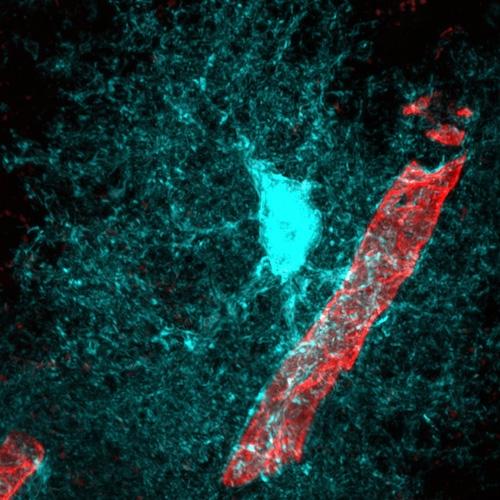When thinking about the cells that are involved in neurodegenerative diseases, it is easy to zero in on neurons – the fundamental units of the brain that receive and transmit sensory information. But there is strong evidence to indicate that other cells are also involved in the development and progression of dementia. Among them are macroglia cells; the focus of the UK DRI’s newest research theme.
Macroglia is a collective term that refers to astrocytes and oligodendrocytes, both of which have different supportive functions – helping neurons stay healthy, and the brain operate optimally.
Dr Blanca Diaz-Castro (UK DRI at Edinburgh) co-leads the macroglia theme alongside Prof Siddharthan Chandran. She has been researching astrocytes for over a decade, since finishing her PhD.
“During my PhD I mainly studied neurons. In the early 2000s, very few labs investigated glial cells. Neuroscience was very neuron centric. One day, a visiting Professor gave a talk about his lab’s research on astrocyte functions. I was fascinated by these cells; it was love at first sight! I learned that astrocytes populate the whole nervous system, yet we did not know much about what they were doing. It was such a big unknown; I felt very drawn to contributing to solve this mystery.”
researchers from across the UK DRI are part of the macroglia theme
Having researchers from many different scientific backgrounds come together in the same room aids discussions that lead to new ways of thinking about a problem. Facilitating collective creativity and supporting interdisciplinary team work will bring us closer to a cure for dementia.Dr Blanca Diaz-CastroGroup Leader at the UK DRI at Edinburgh
Dr Diaz-Castro explains why researchers are interested in macroglia in the context of dementia.
“We now know that the function of these cells is altered in dementia, because we can measure their functionality and it differs to that of the healthy brain. We’re still trying to understand whether they are being protective, compensating for damage, or if they’re actually contributing to the harmful environment when the brain is in a diseased state.”
The macroglia theme, which is made up of around 50 researchers from across the UK DRI who are investigating the role of macroglia in neurodegenerative disease, held its first meeting in May of this year. The group plan to meet biannually, to share knowledge, discuss the latest developments in the field, and to identify and address key questions in macroglia biology and dysfunction.
“I think organizing these meetings is very important,” said Dr Diaz-Castro. “Having researchers from many different scientific backgrounds come together in the same room aids discussions that lead to new ways of thinking about a problem and finding potential solutions. Facilitating collective creativity and supporting interdisciplinary team work will bring us closer to a cure for dementia.”

in cyan, blood vessel in red. Image captured by Dr Isabel Bravo-Ferrer.
Dr Lorena Arancibia Carcamo, a senior researcher based at the UK DRI at UCL, attended the initial meeting of the macroglia theme.
“The meeting was a great opportunity to interact with other UK DRI Group Leaders and really bring together the importance of all glia in neurodegenerative diseases," she said.
“I think this is a great theme to join. Macroglia have been long known to be major players in regulating neuronal function but are quite often overlooked when researching neurodegenerative diseases. It was great to talk to other Group Leaders with such diverse research backgrounds yet converging on the same idea that there is much to be explored when it comes to the interactions between neurons and glia, and glia and other glia, in disease.”
As well as the yearly meeting, the theme will instigate training and sharing of knowledge and tools among its members.
“We aim to provide a platform for all members to contribute and benefit from,” said Dr Diaz-Castro. “We’ll hold lectures for researchers to present their work and encourage the sharing of tools and data. We will promote knowledge exchange by facilitating training periods between macroglia theme labs. It’s all about promoting interaction between members.”
Not only does Dr Diaz-Castro hope to foster connection between theme members, but she also envisions integration with the other UK DRI research themes.
“We don’t want to just look at macroglial cells in isolation,” she explained. “Because, of course, it doesn’t work like that in the brain, everything is integrated. Into our plans, we also include the organization of meetings where 2 or 3 of the UK DRI themes come together and exchange ideas.”
Find out more about the macroglia theme on our research themes page. If you would like to join the macroglia theme, please contact Dr Diaz Castro or Research Themes Manager Dr Helen Brooks.
To stay up to date on the latest research news and Institute updates, sign up to receive our monthly newsletter, ‘Inside Eye on UK DRI'.
Article published: 25 October 2022
Banner image: Human stem cell-derived myelinating oligodendrocyte can be seen with many myelinating processes wrapped around unstained neurons. Courtesy of Dr Owen Gwydion James, Prof Siddharthan Chandran’s lab, UK DRI at Edinburgh.
Second image: Astrocyte in cyan, blood vessel in red. Image captured by Dr Isabel Bravo-Ferrer, Dr Blanca Diaz-Castro's lab, UK DRI at Edinburgh.
